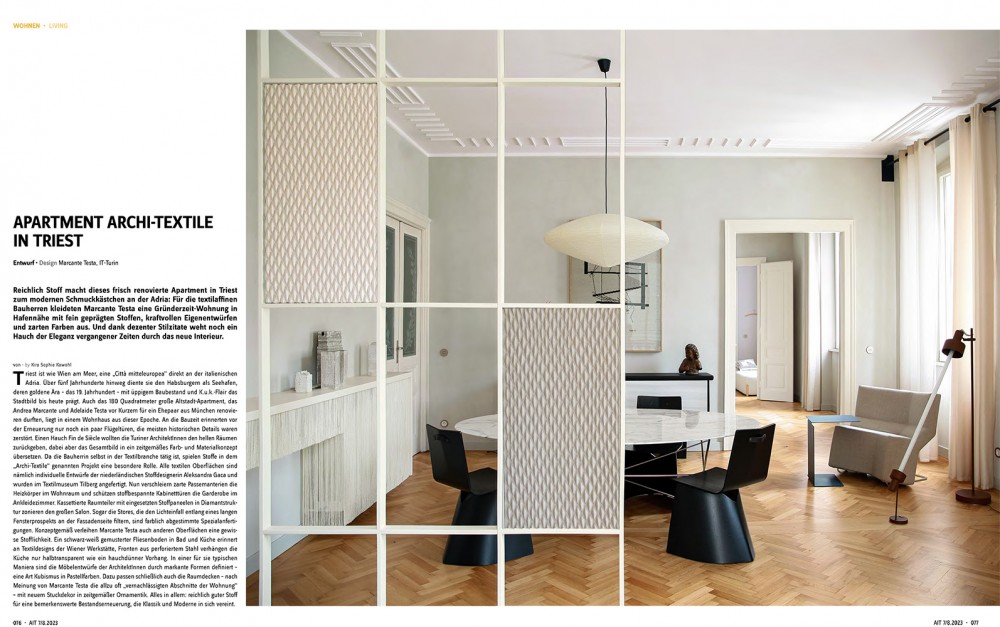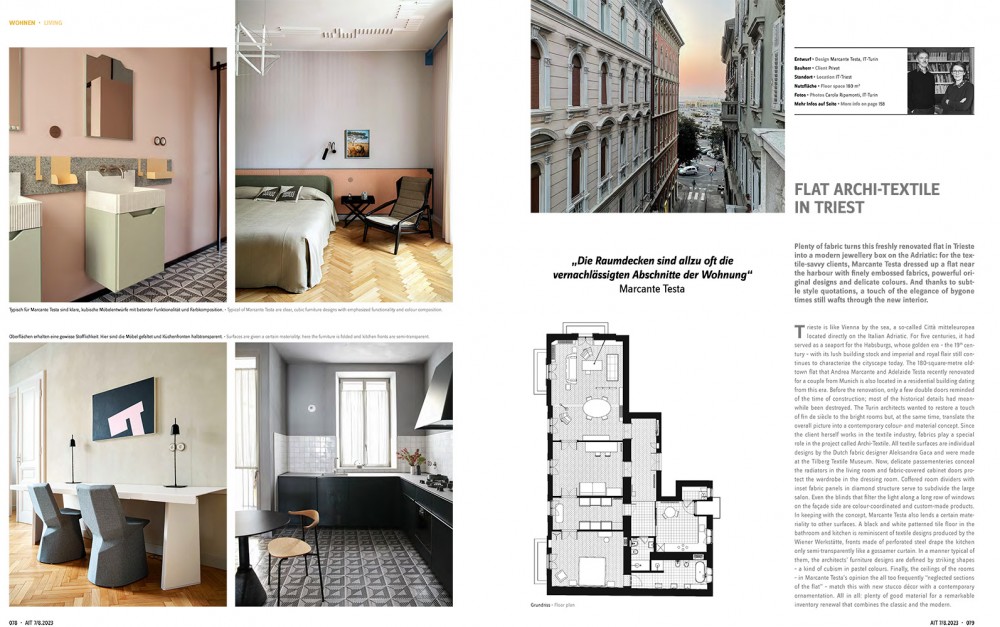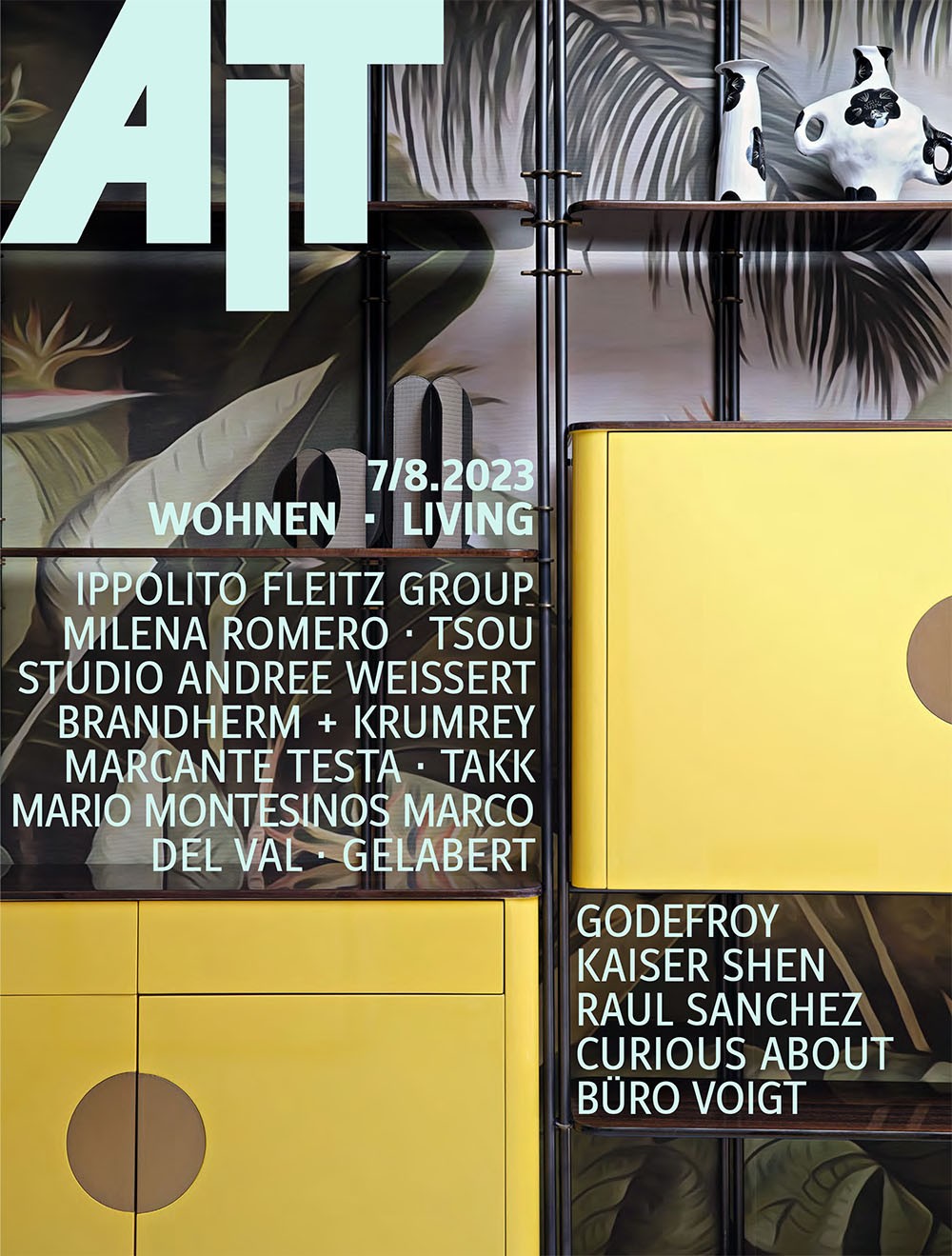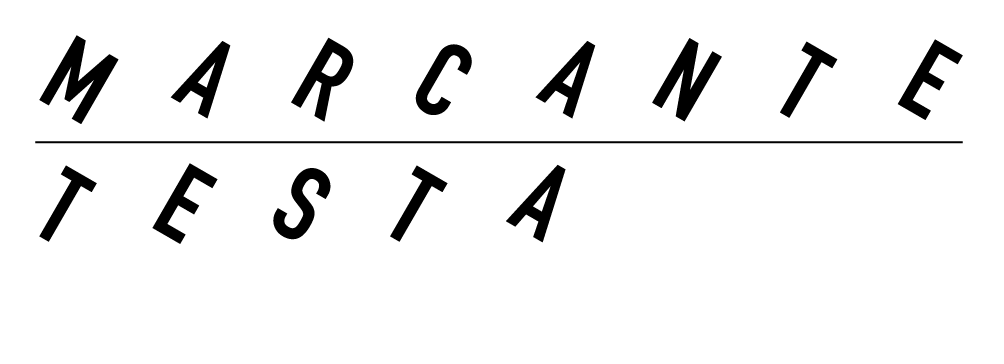“Plenty of fabric turns this freshly renovated flat in Trieste into a modern jewellery box on the Adriatic: for the textile-savvy clients, Marcante Testa dressed up a flat near the harbour with finely embossed fabrics, powerful original designs and delicate colours. And thanks to subtle style quotations, a touch of the elegance of bygone times still wafts through the new interior.”
Words by Kira Sophie Kawohl – Photos by Carola Ripamonti



Trieste is like Vienna by the sea, a so-called Città mitteleuropea located directly on the Italian Adriatic. For five centuries, it had served as a seaport for the Habsburgs, whose golden era – the 19th century – with its lush building stock and imperial and royal flair still continues to characterize the cityscape today. The 180-square-metre oldtown flat that Andrea Marcante and Adelaide Testa recently renovated for a couple from Munich is also located in a residential building dating from this era. Before the renovation, only a few double doors reminded of the time of construction; most of the historical details had meanwhile been destroyed. The Turin architects wanted to restore a touch of fin de siècle to the bright rooms but, at the same time, translate the overall picture into a contemporary colour- and material concept. Since the client herself works in the textile industry, fabrics play a special role in the project called Archi-Textile. All textile surfaces are individual designs by the Dutch fabric designer Aleksandra Gaca and were made at the Tilberg Textile Museum. Now, delicate passementeries conceal the radiators in the living room and fabric-covered cabinet doors protect the wardrobe in the dressing room. Coffered room dividers with inset fabric panels in diamond structure serve to subdivide the large salon. Even the blinds that filter the light along a long row of windows on the façade side are colour-coordinated and custom-made products. In keeping with the concept, Marcante Testa also lends a certain materiality to other surfaces. A black and white patterned tile floor in the bathroom and kitchen is reminiscent of textile designs produced by the Wiener Werkstätte, fronts made of perforated steel drape the kitchen only semi-transparently like a gossamer curtain. In a manner typical of them, the architects’ furniture designs are defined by striking shapes – a kind of cubism in pastel colours. Finally, the ceilings of the rooms – in Marcante Testa’s opinion the all too frequently “neglected sections of the flat” – match this with new stucco décor with a contemporary ornamentation. All in all: plenty of good material for a remarkable inventory renewal that combines the classic and the modern.
—-
Reichlich Stoff macht dieses frisch renovierte Apartment in Triest zum modernen Schmuckkästchen an der Adria: Für die textilaffinen Bauherren kleideten Marcante Testa eine Gründerzeit-Wohnung in Hafennähe mit fein geprägten Stoffen, kraftvollen Eigenentwürfen und zarten Farben aus. Und dank dezenter Stilzitate weht noch ein Hauch der Eleganz vergangener Zeiten durch das neue Interieur.
Triest ist wie Wien am Meer, eine „Città mitteleuropea“ direkt an der italienischen Adria. Über fünf Jahrhunderte hinweg diente sie den Habsburgern als Seehafen, deren goldene Ära – das 19. Jahrhundert – mit üppigem Baubestand und K.u.k.-Flair das Stadtbild bis heute prägt. Auch das 180 Quadratmeter große Altstadt-Apartment, das Andrea Marcante und Adelaide Testa vor Kurzem für ein Ehepaar aus München renovieren durften, liegt in einem Wohnhaus aus dieser Epoche. An die Bauzeit erinnerten vor der Erneuerung nur noch ein paar Flügeltüren, die meisten historischen Details waren zerstört. Einen Hauch Fin de Siècle wollten die Turiner ArchitektInnen den hellen Räumen zurückgeben, dabei aber das Gesamtbild in ein zeitgemäßes Farb- und Materialkonzept übersetzen. Da die Bauherrin selbst in der Textilbranche tätig ist, spielen Stoffe in dem „Archi-Textile“ genannten Projekt eine besondere Rolle. Alle textilen Oberflächen sind nämlich individuelle Entwürfe der niederländischen Stoffdesignerin Aleksandra Gaca und wurden im Textilmuseum Tilberg angefertigt. Nun verschleiern zarte Passemanterien die Heizkörper im Wohnraum und schützen stoffbespannte Kabinetttüren die Garderobe im Ankleidezimmer. Kassettierte Raumteiler mit eingesetzten Stoffpaneelen in Diamantstruktur zonieren den großen Salon. Sogar die Stores, die den Lichteinfall entlang eines langen Fensterprospekts an der Fassadenseite filtern, sind farblich abgestimmte Spezialanfertigungen.
Konzeptgemäß verleihen Marcante Testa auch anderen Oberflächen eine gewisse Stofflichkeit. Ein schwarz-weiß gemusterter Fliesenboden in Bad und Küche erinnert an Textildesigns der Wiener Werkstätte, Fronten aus perforiertem Stahl verhängen die Küche nur halbtransparent wie ein hauchdünner Vorhang. In einer für sie typischen Maniera sind die Möbelentwürfe der ArchitektInnen durch markante Formen definiert – eine Art Kubismus in Pastellfarben. Dazu passen schließlich auch die Raumdecken – nach Meinung von Marcante Testa die allzu oft „vernachlässigten Abschnitte der Wohnung“ – mit neuem Stuckdekor in zeitgemäßer Ornamentik. Alles in allem: reichlich guter Stoff für eine bemerkenswerte Bestandserneuerung, die Klassik und Moderne in sich vereint.

